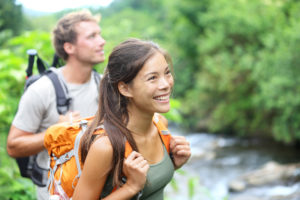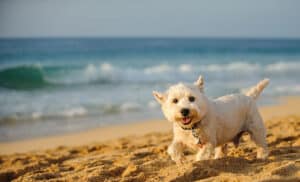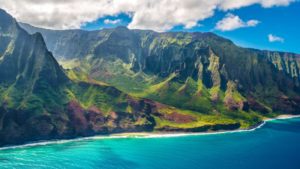Golf is golf is golf the world around, right? Or so you might assume by looking at the names and nationalities of players on America’s various professional tours — from throughout Asia, Europe, South America and Africa. The “auld game” of Scotland has truly become an international spectacle and passion.
And with Hawaii being America’s 50th State, you might well assume that golf here is just like it is wherever you call home. Well, yes. And, well, no.
Yes, we play 18 holes at a time and enjoy a stop afterward at the 19th hole, but from the first tee to the last beverage, Island golf is different. Here are a few suggestions to make your golf in the islands more pleasant.
Leave the Sticks at Home
Really, you can play without them. Most resort courses and many daily fee courses provide rental clubs, and they’re often the latest lines from Titleist, Ping, Callaway, TaylorMade, Tommy Armour or Cobra. This is true for both men and women, as well as left-handers. Which means you don’t have to schlepp your clubs across the Pacific and can give the newest clubs a test drive. Of course, call ahead or go on-line to check what each course you want to play offers.
Ball and Chain
Likewise, pro shops are well-stocked with balls, tees and other accouterments, so even if you bring your own bag, it needn’t weigh a ton. And given what airlines charge for overweight bags these days, you don’t want it to. Trust one who got nailed.
Man, You’re Loud When You Walk!
Hawaii courses generally do not permit metal spikes. So if you bring your own golf shoes, make sure they’re the greens-friendly rubber variety. Most courses also rent shoes. Call ahead.
Say “Tees”!
By all means, do bring a camera. Don’t, and you’ll wish you had. From waves crashing on the shore to lush jungles to black lava fields to misty mountain forests, the golf courses of Hawaii offer scenic vistas at every turn. Plus, back home, photos of you playing golf in Hawaii will make your friends nearly as jealous as photos of you at the luau with a mai tai in one hand and in the other a beautiful hula dancer.
Our Sun is Stronger than Your Sun
No nah-nah-nah here, just stating the obvious, given Hawaii’s southern latitudes and exposure. The sub-tropical rays here are intense, even in December and January. Which means sunscreen is your new best friend. Buy it, apply it — minimum 30 SPF. No kidding, real men wear sunscreen. Good advice is to apply it, at a minimum, on the first and 10th tees. Yes, it can be greasy, but this is why the golf gods invented handiwipes. Fortunately, if you forget to bring sunscreen, most pro shops offer it.
Create Your Own Shade
Hats are a splendid idea to keep the noggin from getting fried. We say, the broader the bonnet’s brim the better. Logo caps and hats from Hawaii’s courses also make swell souvenirs.
Sweat Shop Golf
Spending four-plus hours in the heat and humidity means you’ll perspire away considerable fluids and energy. So it’s important to drink plenty of water or sports drinks. Many courses provide water coolers and/or beverage carts on the course. Drink more than you think you should. And don’t use the word hydrated, it makes you sound like a fairway.
Gone with the Wind
Intense as the sun can be, the Hawaiian archipelago is blessed with cooling trade winds out of the northeast. Without them we’d be Guam or the Philippines. So for golfers, wind is almost always an issue. Most courses are routed with the prevailing trades in mind, so southwestern kona winds can turn a course completely around. There’s no better example of that than what veteran Island pro Dick McClean accomplished at the par-3 second hole at Kapalua’s Plantation Course. Playing with the trade winds at his back, and NBC golf commentator Mark Rolfing as a partner, Dick hit a 6-iron for a hole-in-one. A week later, playing into a howling kona wind, as Mark began to tell NBC colleague Johnny Miller about Dick’s ace, he nailed a driver — and knocked this one into the hole too!
Hawaiian pros suggest that when playing into the wind you take another club or two or three, and then swing easy — the harder you hit, the more spin it imparts to the ball, which is magnified by the wind.
Native Hawaiians Use More than 40 Terms for Rain
In theory, you can play golf in Hawaii 365 days a year. Fact is, though, there’s a reason these islands are so green. It rains, some places and some seasons more than others. Better to bring an umbrella and light jacket and not use them than to not bring them and get soaked. And remember, to Hawaiians rain is a blessing.
O Wise One, I Have Come Seeking Answers
One of the happy developments in Island golf is that more courses and pros are emphasizing teaching. And many visitors find that they’re more relaxed and receptive to lessons while on vacation. Places such as the sprawling Kapalua Golf Academy and the David Leadbetter Golf Academy at Wailea (both on Maui) offer everything from half-day to multiple-day instructions, including video analysis and customized golf-specific workouts. Every resort course offers similar programs, including “playing lessons,” going out on the course with a teaching pro. It’s always best to make an appointment in advance.
Which has nothing to do with barley, wheat or rye. Or sand.
With just a couple of exceptions, putting greens at Hawaii courses are planted with Bermuda grass. There are a variety of Bermudas — somewhere there are white-coated mad scientists cackling in labs while stewing up new strains — they all have grain. Which describes the direction that blades of grass grow. The three factors in determining grain are the direction of the setting sun, the direction of the trade winds and water drainage. Putting and chipping with the grain, the balls rolls faster and further. Going against the grain, the putt is slower. When it’s sideway, well, I’ve actually seen putts break uphill. The easiest way to determine grain is to check the rim of the hole. The side that shows a slight browning of grass is the direction the grain goes — the browning caused by roots exposed to the blades of a mower.
Design Your Own Course
Resort courses, in particular, offer more than the usual three sets of tees, sometimes four or five. So bite off as much or little challenge as you like. Tee it up from the tips and you’ll find yourself playing a few 600-yard par-5s and see a few 250-yard forced carries.
Ride On
Unless you play a muni or certain daily fee courses, plan on taking a cart. Riding carts are mandatory at most courses and are included in the greens fees. More and more courses are offering on-board GPS.
Bargains Galore
Most courses offer “twilight” rates, usually a substantial savings over the morning — which is preferred because the sun is less intense and wind tends to come up in the afternoon. Exactly when twilight begins varies from course to course, generally from 11:30 a.m. to 3:30 p.m.
Tough Lies
Lava tends to be razor-sharp and not good for the life of golf balls, golf shoes or golf clubs. So if you hit a ball into the black stuff, consider it an offering to Madame Pele, goddess of the volcano, and drop another one. At Waikoloa’s Kings and Beach courses on the Big Island, they tell first-timers that, if they should hit one toward the lava, to call out to a friendly neighborhood menehune, “Moki! Moki! Moki!” Sometimes it actually works and he kicks it back.
Tastes Better than it Sounds
At the end of your round, there’s a 19th hole where you can enjoy a chilled beverage and some pupus. Which is the Hawaiian word for appetizers, or perhaps in hipper modern parlance, tapas. Edamame, steamed soy beans, is a particular Island fave. Some of our favorite 19th holes include Ko Olina (Oahu), which is set above a waterfall and splashes down beside the 18th green; Plantation Course (Maui), great food with a view down the 9th fairway toward the blue Kaiwi Channel and beyond the island of Molokai; Arnie’s at Hapuna (Big Island), great food and a virtual Arnold Palmer museum; Kaanapali (Maui), where you can watch other golfers struggling with the watery 18th hole, one of the state’s toughest par-4s.
Lastly, Some Very Deep Hawaiian Philosophy
Don’t forget to stop and smell the plumerias.








